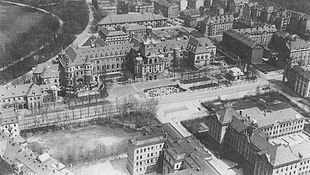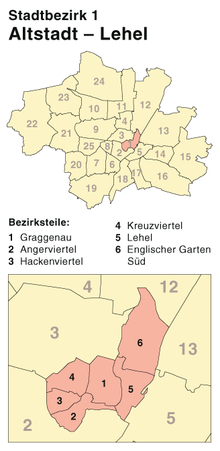Altstadt-Lehel
|
Altstadt-Lehel
State capital Munich
Coordinates: 48 ° 8 ′ 10 ″ N , 11 ° 34 ′ 20 ″ E
|
|
|---|---|
| Area : | 3.15 km² |
| Residents : | 21,126 (Dec. 31, 2019) |
| Population density : | 6,716 inhabitants / km² |
| Postcodes : | 80331, 80333, 80335, 80336, 80469, 80538, 80539 |
| Area code : | 089 |
|
Location of the city district 1 Altstadt-Lehel in Munich
|
|

Altstadt-Lehel (pronounced: "Smile") is the city district 1 of the Bavarian capital Munich .
The city district consists of the districts of Altstadt and Lehel .
location
The city district includes the historic old town on the one hand and the Lehel on the other, which connects to the north-east of the old town.
The border of the old town is essentially formed by the old town ring. Exceptions are the Galeriestraße - Brienner Straße in the north and the Müllerstraße-Rumfordstraße in the southeast.
The Lehel is bordered by the Isar in the east and the Königinstraße in the west as well as the Tivolistraße in the north and the Zweibrückenstraße in the south. In the southwest the Altstadtring forms the border with the old town. The northern part of the Museum Island and the Prater Island also belong to the Lehel.
Neighboring districts are Schwabing-Freimann in the north, Bogenhausen and Au-Haidhausen in the east on the other bank of the Isar, Ludwigsvorstadt-Isarvorstadt in the south and south-west and Maxvorstadt in the north-west.
Subdivision
The Altstadt-Lehel district comprises two districts of Munich :
- the old town , which corresponds to the historic city center , which was surrounded by the Munich city fortifications in the Middle Ages , and
- the Lehel , which has been part of the Munich truce since the Middle Ages and is therefore often referred to as the “oldest suburb” of Munich.
For administration and statistical purposes, the Altstadt-Lehel district is divided into six districts, which, however, are based on the historic districts.
The first four parts of the district roughly correspond to the historic quarters of the old town.
statistics

(As of December 31, residents with main residence)
| year | Residents | including foreigners | Inhabitants per km² |
|---|---|---|---|
| 2000 | 18,374 | 4,219 (23.0%) | 5,808 |
| 2001 | 18,462 | 4,227 (22.9%) | 5,836 |
| 2002 | 18.193 | 4,079 (22.4%) | 5,751 |
| 2003 | 18,159 | 4,178 (23.0%) | 5,740 |
| 2004 | 18,210 | 4,108 (22.6%) | 5,756 |
| 2005 | 18,631 | 4,261 (22.9%) | 5,889 |
| 2006 | 18,876 | 4,154 (22.0%) | 5,976 |
| 2007 | 19,228 | 4,290 (22.3%) | 6,088 |
| 2008 | 19,505 | 4,386 (22.5%) | 6,201 |
| 2009 | 18,932 | 3,925 (20.7%) | 6,019 |
| 2010 | 19.207 | 4,039 (21.0%) | 6.106 |
| 2011 | 19,707 | 4,356 (22.1%) | 6.265 |
| 2012 | 20,048 | 4,729 (23.6%) | 6,373 |
| 2013 | 20,422 | 5,053 (24.7%) | 6,492 |
| 2014 | 20,806 | 5,371 (25.8%) | 6,614 |
| 2015 | 21,122 | 5,579 (26.4%) | 6,715 |
| 2016 | 21,454 | 5,872 (27.4%) | 6,820 |
| 2017 | 20,926 | 5,493 (26.2%) | 6,652 |
| 2018 | 21,100 | 5,550 (26.1%) | 6,708 |
| 2019 | 21,126 | 5,502 (26.0%) | 6,716 |
Source with further data
politics
The district committee of Altstadt-Lehel was last elected on March 15, 2020. The distribution of seats is as follows: CSU 4, Greens 6, SPD 3, and FDP 1. Of the 16,074 residents who are entitled to vote in Altstadt-Lehel, 8,404 have exercised their right to vote, bringing the turnout to 52.3 percent.
The constituent meeting took place on May 14, 2020 in the large meeting room of Munich City Hall. The committee elected the architect Andrea Stadler-Bachmaier as the new district committee chairman. For the first time, the committee is chaired by a representative from Alliance 90 / Greens. Wolfgang Püschel (SPD) was elected as the first deputy, and Stefan Blum (CSU) was elected as the second deputy. The district committee has organized itself into three committees for future work: Mobility and Public Space (Chair: Philippe Louis, Greens) - Planning, Building, Living (Chair: Wolfgang Püschel, SPD) - Culture, Social Affairs, Gastronomy and Budget (Chair: Markus Stadler, Greens).
See also
- List of architectural monuments in Munich's old town
- List of architectural monuments in Lehel
- List of places in Munich
- List of Münchner Höfe # Altstadt-Lehel
literature
- Florian Breu: The Munich districts after the urban area reorganization . In: Munich Statistics . No. 1 , 1996, ISSN 0171-0583 , p. 1-14 .
- Klaus Gallas : Munich. From the Guelph foundation of Henry the Lion to the present: art, culture, history . DuMont, Cologne 1979, ISBN 3-7701-1094-3 (DuMont documents: DuMont art travel guide).
- Helmuth Stahleder : From Allach to Zamilapark. Names and basic historical data on the history of Munich and its incorporated suburbs. Edited by Munich City Archives . Buchendorfer Verlag, Munich 2001, ISBN 3-934036-46-5 .
Individual evidence
- ↑ Statistical Pocket Book 2020 (PDF). Statistical Office of the State Capital Munich. Retrieved August 25, 2020.
- ^ Archive district information . State capital Munich. Retrieved January 1, 2019.
- ↑ a b c Election of the District Committee - District 1 - Altstadt-Lehel . State capital Munich. Accessed April 30, 2020
- ↑ SZ: Overture with discord on May 16, 2020



